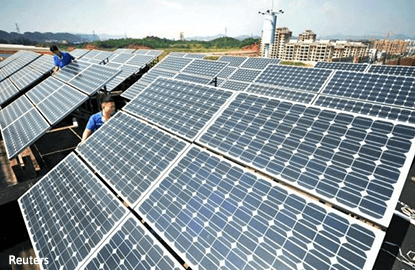
FOR companies that have jumped onto the renewable energy bandwagon, the government’s move to develop utility-scale solar (USS) power plants was supposed to be a catalyst for the industry.
They were right to think there was money in solar — unfortunately, none of the listed companies have been able to secure a slice of the action.
Instead, the first block of USS was awarded to a relatively unknown consortium with no track record or expertise in solar — Quantum Solar Park Malaysia Sdn Bhd (QSP).
The 3x50mw of solar capacity awarded by the Energy Commission will cost an estimated RM1.3 billion at least to develop, excluding land acquisition costs. Note that the project is spread over three states — Melaka, Kedah and Terengganu — in blocks of 50mw each.
QSP may become the largest solar generator in the country, dwarfing Edra Global Energy Bhd’s 50mw plant that is slated for development in Kedah.
Edra Global’s project was estimated to cost around RM420 million, not including land acquisition costs.
The award raises questions whether companies that have already been investing into solar, like Cypark Resources Bhd, Vsolar Group Bhd and PUC Founder (MSC) Bhd, will be able to get a slice of the action in the future.
“150mw is huge for solar. The question is, did it have to be awarded all to one player? This is a billion-ringgit project and Quantum Solar has no track record for a project of this size. Surely, the three projects could have been spread among more players,” says an industry veteran.
According to industry sources, QSP also managed to secure a relatively lucrative tariff for its solar projects of up to 50 sen per kWh. This is the same rate that Edra Global managed to secure.
“A 50mw plant will have good economies of scale, so 50 sen per kWh is a good rate. At 150mw, the economies of scale would be even better, even if it is spread across three different sites. It should easily be able to generate double-digit IRRs (internal rate of returns),” adds the industry veteran.
On one hand, this rate is lower than the lowest feed-in-tariff (FiT) solar rates for existing plants — 61.2 sen per kWh. Note, the largest plants awarded under the FiT program is 10mw. The smaller plants do not benefit from economies of scale and require higher tariffs.
However, QSP’s rate is also more expensive than the lowest possible tariff for FiT projects listed on Sustainable Energy Development Authority Malaysia’s (Seda) website, which is 41.62 sen per kWh. This rate is for plants between 10mw and 30mw.
The FiT programme however, is subsidised and funded by the 1.6% renewable energy levy imposed on customers. The additional cost for the USS programme will be borne by Tenaga Nasional Bhd, unless it is passed on to consumers. The current base tariff is only 38.5 sen per kWh.
So who are the beneficiaries of the USS programme thus far?
A check on the Companies Commission of Malaysia’s website, shows that QSP is almost equally 33.33% owned by Itramas Technology Sdn Bhd, MalTechPro Sdn Bhd and Cam-Lite Sdn Bhd. Note however, that Maltech Pro has one share more than Itramas and Cam-Lite.
Among the three companies, Itramas is the largest company by far in terms of revenue. In FY2014, Itramas generated RM44.2 million in revenue. Itramas specialises in LED lighting. It has dabbled in solar, but only on a small scale.
According to Itramas’ website, the company has installed about 100 small solar panels for roadside equipment. This is hardly on par with the scope of a USS project.
Itramas’ ultimate controlling shareholders are Lee Choo Boo and Gan Geik Lee.
However, it is MalTechPro that has caught the most attention. The company is best known for developing the 1Malaysia Pad, an Android tablet. The company claimed to launch the first 5,000 units at an introductory price of RM999.
More interesting than the tablets are the company’s shareholders. It includes Umno Supreme Council member Datuk Sohaimi Shahadan, who has a 35% stake. Sohaimi is also the non-executive chairman at BHS Industries Bhd and non-executive chairman at EKA Noodles Bhd (formerly KBB Resources Bhd). He is also the non-executive chairman at PDZ Holdings Bhd.
Meanwhile, Ahmad Zaffry Sulaiman, who has a 20% stake, is an Umno leader for Shah Alam. He is also a director at EKA Noodles.
Lastly, Cam-Lite is controlled by Zainoor Sulaiman (90% stake) and his daughter Zelita Zainoor (10%). Zainoor was listed as director at Itramas in 2010. He has since left.
Combined, QSP’s three shareholders are still relatively small in size compared to the estimated RM1.3 billion solar project that they have been awarded.
|To be fair, even the listed players look relatively small. Cypark is by far the largest of the listed solar players with 34.6mw of capacity. The group’s share price has gained 22.3% y-o-y, close at RM2.16 last Thursday, valuing the company at 11.09 times earnings.
Vsolar is much smaller: It has only completed 1mw of solar capacity under the FiT programme. The company has been trying to raise up to RM115 million via a rights issue in order to fund its expansion into solar. However, it has been given a six-month extension to March next year to complete the rights issue.
After surging 66% to a high of 12.5 sen in the middle of the year, Vsolar’s share price has since fallen to 6.5 sen apiece on lack of newsflow.
PUC Founder also has 1mw of solar capacity under the FiT programme. Like Vsolar, it also raised money via a rights issue of irredeemable convertible unsecured loan stocks (ICULS) to fund its solar expansion. The group managed to raise RM42.65 million earlier this year from the exercise, but has not been able to secure a new project yet.
Save by subscribing to us for your print and/or digital copy.
P/S: The Edge is also available on Apple's AppStore and Androids' Google Play.